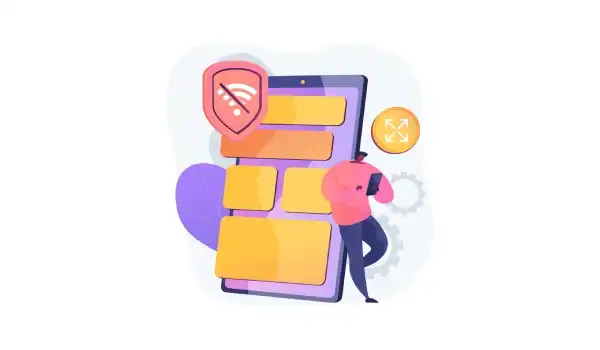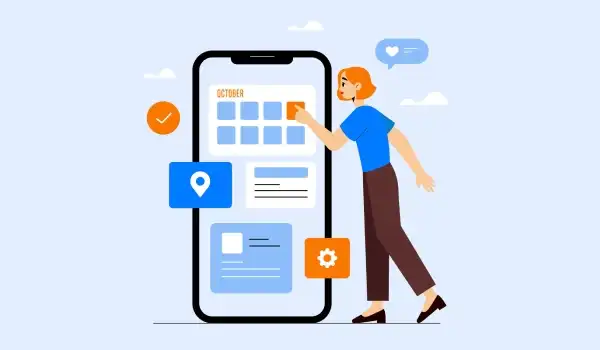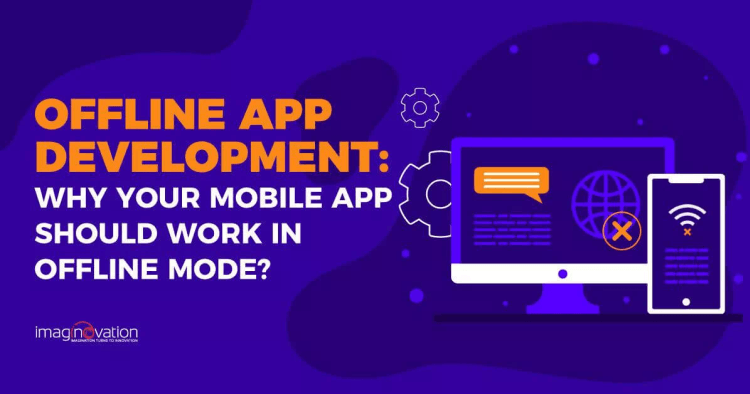Today, the offline mode has become one of the must-have functionalities of mobile applications.
You see, with mobile apps, user experience is everything. It has a huge impact on the success of your app. If users can’t use your mobile app due to a poor network, it can lead to a bad user experience.
Mobile applications aren’t truly mobile if they can’t function offline.
So, how to create a mobile app that can also work offline?
Let’s find out.
What is Offline Mode?

Offline mode is a feature that allows users to access mobile apps without the Internet.
The feature is being used in many apps such as Amazon Kindle, Uber, and Google Maps. Offline mode limits a user’s inconvenience when the internet connection is lost or intermittent.
Now, it doesn’t mean that users will be able to access these apps in offline mode forever. The apps will need an Internet connection at some point to enable data synchronization.
Why Implement Offline Mode in Your App?
You might be wondering how does offline mode would benefit your business, apart from allowing customers to access your app without the internet.
Well, there’s more to it.
Here’s a list of reasons why you must build business apps that work offline.
1. Get A Competitive Edge
There are various factors based on which users select one app over the other – functionality, performance, UI, and UX.
With 8.9 million mobile apps available, there’s no dearth of sufficient mobile apps. Many apps with similar features like – Telegram and WhatsApp, Spotify and YouTube Music, or Lyft, and Uber compete for user’s preference.
Launching an offline app over the online app or adding an offline feature to your app can give you a competitive advantage.
2. Improved Customer Loyalty
Users love mobile apps that work without any delays or difficulties. Adding offline functionality to your app will make the users more loyal to your app because
- Users can access their data, regardless of an internet connection
- The app becomes faster & loads quickly
- Offline apps are less likely to consume your phone’s battery
3. Saves Mobile Battery Power
Apps with consistent high battery drainage are highly unpopular among users. Users particularly face battery drainage of their phones with prolonged network connection, say while traveling.
Offline compatible apps with a fast loading speed, and efficient data storage management, result in the phone’s battery saving. It is quite helpful when the user isn’t sure when they’ll find a place to charge their phone.
4. No Roaming Expenses
Some apps need massive data that can be accessed with a data plan. A roaming data plan is used while traveling in other countries or states and is expensive.
An offline feature in your app can save you money and data at the same time.
Offline Mode Apps: Typical Use Cases
Even if you want it, Internet access is not ubiquitous. All of us can relate to the frustration of being offline.

When you design a mobile app for your business that doesn’t work without the Internet, you decide exactly where and when your app will be used.
But there are many instances where your users won’t have Internet connectivity.
- Imagine you’re traveling to a new country, and you can’t afford the data plan there.
- You don’t want to pay for Wi-Fi while on the flight.
- You are on a trip to a remote destination with friends.
- You are road traveling, and there are certain areas where the connectivity is poor.
Let us check some typical scenarios where offline mode apps may be essential.
1. On-demand Delivery
A delivery guy loses connection while on his way to a customer’s location. Even if he knows his way, he has no way to report back to the employer or to communicate with the client in case:
- He can’t find his way into the apartment building.
- He is caught in traffic and is late.
But, with an offline mode, the delivery guy updates the order form – “I’ll be there in 10 minutes”. And continue his way with updates sent automatically once a proper connection is re-established.
2. Online Cash Transfers
Imagine you urgently need to make a money transfer to your friend. And you’re in a building with a poor connection.
What will you do about it? Will you go all the way out just to make the transaction requested or ignore your friend’s urgent requirement?
With the offline mode, you will enter all the transaction details and make the transfer. The app will complete an actual transaction later as soon as the connection is re-established.
3. E-commerce
Suppose you have a supermarket shopping app that you are trying to use in the basement of a friend’s house, where the Wi-Fi signals are intermittent.
With a traditional online app, filling the cart requires the app to go back and forth to the server at regular intervals, but it’s slow and frustrating because of the poor connection.
With the offline first, content (directory of the supermarket products) of the app is moved to the app. It speeds up your shopping experience. You need to make the actual payment and schedule the delivery once your connection is re-established.
4. File Uploads
File uploads do not stop entirely in the offline mode. Using an offline app, file uploads are queued-up when there is no connectivity and are uploaded automatically as soon as it finds the connection.
5. News Portals
Commuting time provides many of us the perfect time to catch up on the stories of the day with our favorite News App.
With unreliable connectivity, the content available will be dated from the time we were last online. The offline version will not play any videos or share content.
How to Implement Offline Mode in Your App?
Things to take care of while implementing offline mode in your app:
1. Show a Proper User Interface for the Offline State
Clear communication, they say, is the key to a successful customer experience strategy. This must be kept in our minds when designing the user interface for the offline state. You must:
- Remember, offline is not an error state.
- Use the app’s skeleton (minimal UI framework) to decide what to show to users.
- Notify the users when the app detects low or unavailable network conditions.
- Not show error messages that are nothing more than jargon.
2. Make Static Information Available
In the apps that work with limited connectivity, the static information gets downloaded and stored locally when it first loads. This data is not modified frequently.
You can see it in the Google Maps app. This app comes with an offline functionality that facilitates the users to navigate locations on the Google map and expand to some level of detail even when the connection drops.
3. Create a Cache of Commonly Used Dynamic Data
As compared to static caching, dynamic cache data is expected to be updated frequently.
To enable this in a limited or zero connectivity environment, users’ information is stored temporarily in the local cache (this process is most commonly seen in PWAs) – this prevents a blank screen during the offline mode.
The approach is used heavily by many gaming and social media applications.
4. Real-Time Data Synchronization
Modern apps have gotten their users accustomed to automatic data synchronization that runs in the background. The user in this is not bothered about data updates. It is convenient for users, and users expect it as a standard in all cases.
But this approach is not feasible in offline cases where the app will be in an inconsistent state because of long sync processing time. It is best to use the manual data synchronization process, which the user can control.
With the help of many advanced synchronization protocols, the offline app that uses this method can transfer the changed data version and the actions taken to edit it.
Tips for Selecting Offline Features for your App
While there is no quick-fix solution to build a perfect offline mode for your app, you must do some checks and get clarity. Here are some tips to help you:
- Check and assess your workflow, decide your business requirements, and translate them into application features.
- Give preference to the user-critical features as once they become crucial for your business, they become urgent.
- Determine what you must accomplish through your app.
- Share this information with your developers. Let them understand your business objectives and recommend precise technologies for a custom-based app solution.
While building your mobile app, do not use and test your app only on a stable connection because it will surely work.
To stand out and provide an optimal user experience, you should cover all cases – and consider the case of a compromised or failed internet connection.
- Analyze user sessions and get an insight into how your users use your app and which sessions can be used offline.
- Build an offline-first approach. Your app’s offline functionality shouldn’t only be an afterthought. It can begin early on.
- Take critical features and make them work offline. Instead of making all the features offline, select key features that must work offline.
Choosing the Right Technology for Offline Mode

It’s essential to select the right technologies while developing your offline app. Pay attention to and consider the following when making the big decision about technology use:
1. Data Synchronization – Frequency
When a mobile app is used offline, you must sync certain actions and data with the server. This syncing happens whenever an internet connection is available.
Reconnecting to the Internet and syncing too often will drain a phone’s battery. But if an app synchronizes only occasionally, users might miss some essential updates.
Solution?
Work with your app developers to find the right balance between the two. To do that, you’ll have to evaluate how often your users can access high-speed internet.
If people use your app for work purposes, define which slots in their work schedules are best for downloading the data. The better the data connection, the shorter those slots will be.
2. Data Synchronization – Cycles and Time
Data synchronization cycles vary. The business needs to determine how the data will be prioritized. Some data must be updated only once a year, while others need to be updated multiple times a day.
It is advisable to determine different synchronization cycles for different data according to the business needs.
The smaller the data packages needing high-frequency updates, the better it is. Your app may not need consistent data synchronization. Even if it does, you can sync data at a scheduled and specific time.
3. Managing Changes in Shared Data
In a business scenario, if some users are not online, modification in data cannot be accessible to others. Thus, many users may work on similar information without really checking for how others have changed it.
In case you cannot avoid such a scenario, focus on exception managing and deciding rules for handling those exceptions.
4. Handling Sensitive Data
Private user-information cannot be removed for security reasons.
Downloaded data like blog posts and logos etc. are stored in the cache folder on the user’s device, so it doesn’t require to be downloaded each time the user accesses and uses that content.
By pushing the Back button on your browser or checking the cache of the browser, you can view the cached info.
This puts sensitive information like usernames and credit card details at risk. Therefore, do ensure sensitive info is not cached.
5. Method of Syncing
To select the most precise technologies for offline mode, check:
- Whether the data transfer should be synchronous or asynchronous
- Will the data be synced manually or automatically?
- Will the app actively ask the server for updates or the server will send new data itself to the app?
Create Incredible Offline App Experience with Imaginovation
Not all apps need to be built entirely offline. Nevertheless, adding offline features makes way for a better user experience.
Are you ready to get an offline mobile app developed? We will happily assist you with your requirement.
We are an award-winning web and mobile app development company with vast experience in crafting remarkable digital success stories for diverse companies.
Ready to build an app, but not sure where to start?
We've got you covered. Click the button below to get started.





